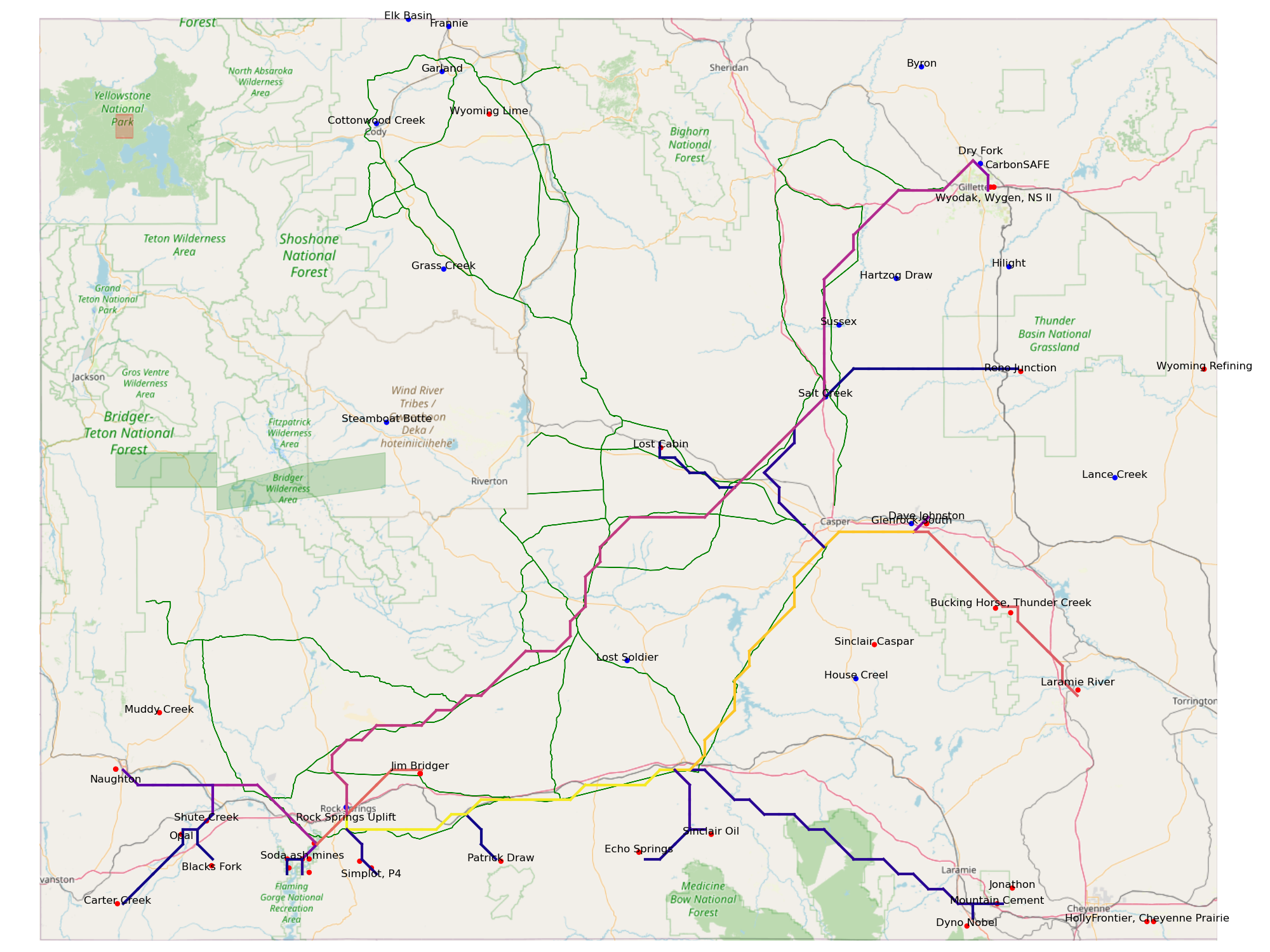(628c) Optimisation of Carbon Capture and Storage Infrastructure in Wyoming to Reduce Carbon Emissions and Maximise Profits
AIChE Annual Meeting
2022
2022 Annual Meeting
Environmental Division
Design and Analysis of Carbon Capture and Negative Emissions Technologies - Models
Thursday, November 17, 2022 - 1:06pm to 1:24pm
Wyoming’s economy heavily depends on the usage and export of fossil fuels and generated energy. Numbers from the US Bureau of Economic Analysis (BEA) show that in 2020 mining, quarrying and oil and gas extraction is the single largest contributor to the state’s gross domestic product (GDP) at 7,923 M$2012, representing 22 % of the total GDP [1]. According to the US Bureau of Labor Statistics (BLS), in February 2022 15,600 jobs were directly associated with the mining and logging industry in Wyoming [2]. CCS is an opportunity to reduce the significant emissions associated with these sectors, making it viable for them to continue operating in a low-carbon future. For this reason, local public and policy support for CCS is high, and significant research has already been undertaken to determine feasibility of capture and storage sites [3] [4] [5]. Additionally, the industry in Wyoming already has experience with carbon infrastructure and EOR. A CCS unit has been operating at Exxon Mobil’s LaBarge gas processing facility since 1986 to separate CO2 from natural gas. The CO2 is then directed into pipelines and sold to EOR customers [6]. It was recently announced that the carbon capture capacity at that site will be extended [7].
Due to revenues from 45Q and EOR, CCS has the potential to be economically viable. However, the capture, transport and storage infrastructure need to be planned carefully in order to reduce costs and maximise profits. We present a CCS value chain optimisation model that can identify optimal investments into CCS infrastructure.
The proposed model is a spatially and temporally resolved capacity-expansion model. Starting from today’s infrastructure, investment into capture plants, storage sites and pipeline networks are optimised on an annual basis until 2050. The target thereby is to maximise profit, defined as difference between revenues from 45Q and EOR and costs, including capture plant, storage well and pipeline investment costs as well as operational expenses. Key constraints include CO2 availability at emitter sites, maximum storage capacities and injectivities as well as maximum annual pipeline build rates. The model is implemented as mixed-integer linear programming problem in Python/Pyomo and solved by Gurobi.
The model can operate with a variable spatial resolution, as default a grid with 10x10 km resolution is used. Inputs are locations of emitter and storage sites; the optimal pipeline network is a model output. It is important to note that the model does not simply connect all emitter and storage sites but identifies the most economical network and operation. We consider all emitter sites from EPA FLIGHT data [8] with annual CO2 emissions greater than 0.1 MtCO2, 42 in total. In terms of storage sites, we consider the two geological storage projects that have been explored, CarbonSAFE and Rock Springs Uplift, as well as 15 potential EOR sites with capacities greater than 20 MtCO2. We also consider pre-approved pipeline corridors from the Wyoming Pipeline Corridor Initiative [9], where installation costs are reduced.
First results show that with current 45Q support levels, limited CCs deployment is profitable, focussing on emitter sites with low carbon capture costs such as gas processing plants, and EOR storage sites. Higher 45Q support, as proposed by lawmakers, results in a widespread rollout of CCS across the state and significant CO2 emission reductions.
The results from this work are not only relevant to identify the most economical CCS infrastructure for given support levels but can also help identify required support levels for defined CCS rollout and/or emission reduction targets. We therefore believe that this research is relevant for a broad range of stakeholders, including industrial players as well as local and central government policymakers.
References
[1] Bureau of Economic Analysis (BEA), “Regional Data - GDP and Personal Income,†31 March 2022. [Online]. Available: https://apps.bea.gov/iTable/iTable.cfm?reqid=70&step=30&isuri=1&major_ar... 56000&year=2020&tableid=512&category=1512&area_type=0&year_end=-1&classification=naics&state=0&statistic=1,2,3,4,5,6,7,8,9,10,11,12,13,14,15,16,17, 18,19,20,21,22,23,24,25,26. [Accessed 04 April 2022].
[2] Bureau of Labor Statistics (BLS), “Economy at a Glance - Wyoming,†01 April 2022. [Online]. Available: https://www.bls.gov/eag/eag.wy.htm. [Accessed 04 April 2022].
[3] Enhanced Oil Recovery Institute, “Wyoming is CCUS Ready!,†02 December 2021. [Online]. Available: https://storymaps.arcgis.com/stories/635fa72880ae4d898157b27bd1995ad0. [Accessed 06 April 2022].
[4] University of Wyoming, “Wyoming CarbonSAFE Project,†[Online]. Available: https://www.uwyo.edu/cegr/research-projects/wyoming-carbonsafe.html. [Accessed 06 April 2022].
[5] F. McLaughlin and K. Coddington, “Integrated Pre-Feasibility Study of a Commercial-Scale CCS Project in Formations of the Rock Springs Uplift, Wyoming,†2017.
[6] MIT - Carbon Capture & Sequestration Technologies, “LaBarge Fact Sheet: Carbon Dioxide Capture and Storage Project,†[Online]. Available: https://sequestration.mit.edu/tools/projects/la_barge.html. [Accessed 06 April 2022].
[7] Reuters, “Exxon plans to increase carbon capture at Wyoming facility,†21 October 2021. [Online]. Available: https://www.reuters.com/business/energy/exxon-plans-increase-carbon-capt.... [Accessed 06 April 2022].
[8] Environmental Protection Agency (EPA), “Facility Level Information on GreenHouse gases Tool (FLIGHT),†07 August 2021. [Online]. Available: https://ghgdata.epa.gov/ghgp/main.do#/listFacility/. [Accessed 06 April 2022].
[9] Bureau of Land Management (BLM), “BLM National NEPA Register,†20 August 2021. [Online]. Available: https://eplanning.blm.gov/eplanning-ui/project/1502028/590. [Accessed 06 April 2022].
